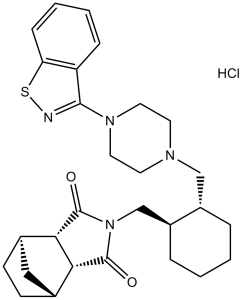Lurasidone HCl (SM-13496)
This product is for research use only, not for human use. We do not sell to patients.

For small sizes, please check our retail website as below: www.invivochem.com
| Size | Price | Stock |
|---|---|---|
| 2g | $150 | Check With Us |
| 5g | $250 | Check With Us |
| 10g | $375 | Check With Us |
Cat #: V1266 CAS #: 367514-88-3 Purity ≥ 98%
Description: Lurasidone HCl (SM-13496; SM 13496; trade name Latuda), the hydrochloride salt of Lurasidone, is an atypical antipsychotic drug that has been approved for the treatment of schizophrenia and bipolar disorder.
Top Publications Citing Invivochem Products
Publications Citing InvivoChem Products
Product Promise

- Physicochemical and Storage Information
- Protocol
- Related Biological Data
- Stock Solution Preparation
- Quality Control Documentation
| Molecular Weight (MW) | 529.14 |
|---|---|
| Molecular Formula | C28H36N4O2S.HCl |
| CAS No. | 367514-88-3 |
| Storage | -20℃ for 3 years in powder formr |
| -80℃ for 2 years in solvent | |
| Solubility In Vitro | DMSO: <1 mg/mLr |
| Water: <1 mg/mLr | |
| Ethanol: <1 mg/mL | |
| Synonyms | SM13496; Lurasidone HCl; SM-13496; SM 13496; trade name Latuda |
| Protocol | In Vitro | Lurasidone (Hydrochloride) (SM-13496 (Hydrochloride)) is an antagonist of dopamine D2 and 5-HT7 with IC50s of 1.68±0.09 and 0.495±0.090 nM, respectively. Lurasidone (Hydrochloride) (SM-13496 (Hydrochloride)) is also a partial agonist of 5-HT1A receptor with an IC50 of 6.75±0.97 nM. In vitro receptor binding experiments reveal that Lurasidone (Hydrochloride) (SM-13496 (Hydrochloride)) demonstrates affinity for dopamine D2 and 5-HT2A receptors higher than other tested antipsychotics. Lurasidone does not increase [35S]GTPγS binding to the membrane preparations for dopamine D2 receptors by itself, but it antagonizes dopamine-stimulated [35S]GTPγS binding in a concentration-dependent manner with a KB value of 2.8±1.1 nM |
|---|---|---|
| In Vivo | Lurasidone (Hydrochloride) (SM-13496 (Hydrochloride)) dose-dependently increases the ratio of DOPAC/dopamine in both regions, but it shows a preferential effect on the frontal cortex compare with the striatum, especially at higher doses. Lurasidone (Hydrochloride) (SM-13496 (Hydrochloride)) (ED50 values 2.3 to 5.0 mg/kg) shows a comparable potency with olanzapine (ED50 values 1.1 to 5.1 mg/kg), higher potency than clozapine (ED50 9.5 to 290 mg/kg), and slightly lower potency than haloperidol (ED50 values 0.44 to 1.7 mg/kg). Lurasidone (Hydrochloride) (SM-13496 (Hydrochloride)) (1 to 10 mg/kg) dose-dependently inhibits conditioned avoidance response (CAR) in rats, and the ED50 values are 6.3 mg/kg. Lurasidone (Hydrochloride) (SM-13496 (Hydrochloride)) dose-dependently inhibits TRY-induced forepaw clonic seizure and p-CAMP-induced hyperthermia with ED50 values of 5.6 and 3.0 mg/kg, respectively. Lurasidone (Hydrochloride) (SM-13496 (Hydrochloride)) (0.3 to 30 mg/kg) dose-dependently and significantly increases the number of shocks received by rats in the conflict test with MED of 10 mg/kg (p<0.01) |
These protocols are for reference only. InvivoChem does not
independently validate these methods.
| Solvent volume to be added | Mass (the weight of a compound) | |||
|---|---|---|---|---|
| Mother liquor concentration | 1mg | 5mg | 10mg | 20mg |
| 1mM | 1.8899 mL | 9.4493 mL | 18.8986 mL | 37.7972 mL |
| 5mM | 0.3780 mL | 1.8899 mL | 3.7797 mL | 7.5594 mL |
| 10mM | 0.1890 mL | 0.9449 mL | 1.8899 mL | 3.7797 mL |
| 20mM | 0.0945 mL | 0.4725 mL | 0.9449 mL | 1.8899 mL |
The molarity calculator equation
Mass(g) = Concentration(mol/L) × Volume(L) × Molecular Weight(g/mol)
Mass
=
Concentration
×
Volume
×
Molecular Weight*
The dilution calculator equation
Concentration(start)
×
Volume(start)
=
Concentration(final)
×
Volume(final)
This equation is commonly abbreviated as: C1 V1 = C2 V2
Concentration(start)
C1
×
Volume(start)
V1
=
Concentration(final)
C2
×
Volume(final)
V2
Step One: Enter information below
Dosage mg/kg
Average weight of animals g
Dosing volume per animal µL
Number of animals
Step Two: Enter the in vivo formulation
%DMSO
+
%
+
%Tween 80
+
%ddH2O
Calculation Results:
Working concentration:
mg/ml;
Method for preparing DMSO master liquid:
mg
drug pre-dissolved in
µL
DMSO(Master liquid concentration
mg/mL)
,Please contact us first if the concentration exceeds the DMSO solubility of the batch of drug.
Method for preparing in vivo formulation:
Take
µL
DMSO master liquid, next add
µL
PEG300, mix and clarify, next add
µL
Tween 80,mix and clarify, next add
µL
ddH2O,mix and clarify.
Note:
- (1) Please be sure that the solution is clear before the addition of next solvent. Dissolution methods like vortex, ultrasound or warming and heat may be used to aid dissolving.
- (2) Be sure to add the solvent(s) in order.




































